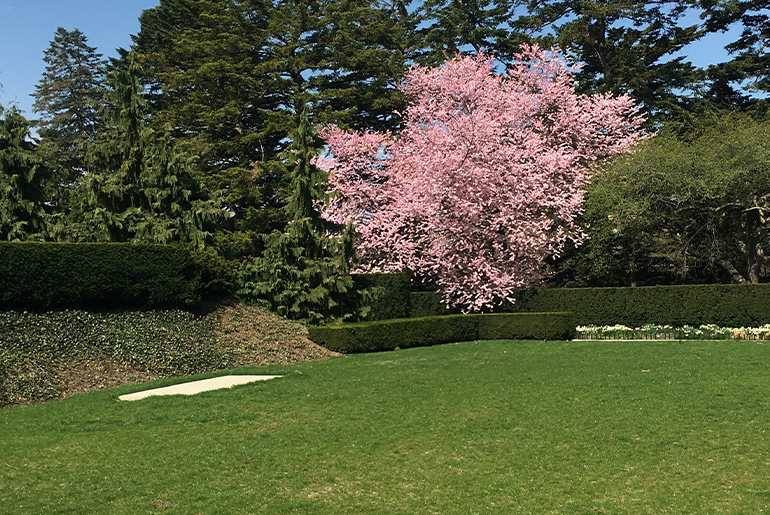One of the great joys of being the WAG editor has been witnessing the delicious synchronicity that happens each month among our stories — often by design, of course, but just as often through sheer kismet. Rarely has this been truer than with this May’s “Reinventing the Landscape” issue, which considers the reciprocal relationship between the arts and the garden.
For centuries, as far back as the Garden of Eden and the Hanging Gardens of Babylon, artists have been depicting gardens. Those depictions in turn have provided inspiration for modern gardens. The owners of the great Gilded Age estates that graced the Hudson Valley and Fairfield County took their cues not only from the aristocratic mansions of Europe but from contemporary painters of the Impressionist and Postimpressionist schools. They wanted homes with “wow” factor. And that meant knockout gardens as well, as you’ll see in Jeremy’s story on Glenmere in Chester, New York, now considered the finest small hotel in North America; and our profiles of the Untermyer Gardens Conservancy in Yonkers, whose strange, twisting fate has had a happy ending; and “Beautiful Work: The Art of Greenwich Gardens and Landscapes,” a new exhibit at the Greenwich Historical Society through Sept. 5.
As “Beautiful Work” demonstrates, the relationship between the arts and the garden hasn’t been abstract. In the case of the American Impressionist painters of the Cos Cob Art Colony who made the historical society’s Bush-Holley House their summer home, they painted, pressed and arranged the flowers and herbs members of their circle planted. Cover subject David Hartt brings this connection between the artist’s hand and eye and the gardener’s into the 21st century with “David Hartt: A Colored Garden,” at The Glass House, the historic New Canaan home of architect Philip Johnson. Hartt, an artist and University of Pennsylvania professor who is also a Black Canadian, creates environments that he then comments on through film, photography or video.
At The Glass House, he’s planted a garden based on the blooms in the luscious 19th-century still lifes of Charles Ethan Porter, one of the first if not the first African-American artists to exhibit at the National Academy of Design, where he studied. By creating such a garden, Hartt isn’t only commenting on Black identity in his and in Porter’s time. (The use of the word “colored” in the title is deliberate.) He’s also offering a counterpoint to Johnson, whose legacy has been clouded by his early white nationalist views. Hartt’s garden will make you think differently not only about peonies but about race relations and cancel culture as well.
But that’s the thing about gardens and the land: They’re not just about themselves. The fruit blossom trees David Hockney depicted at his home in Normandy that bound from the pages of his ravishing new book “Spring Cannot Be Cancelled” aren’t just about fruit blossoms. They’re about defying the coronavirus — as are the works in “Together apArt: Creating During COVID,” at ArtsWestchester in White Plains May 7 through Aug. 1. (See our story on pandemic art.) The Hudson Valley landscape that Congers psychotherapist Vanessa Reiser is running through this month is not just exquisite terrain but a roadmap to raising money to fight narcissistic abuse.
Lush, hot and tangled, gardens are also about, well, sex, intrigue and danger (our opening essay). Botanicals can be poisonous (Gina’s story on the perils they pose to Fido and Fluffy). But they’re also fragile (Phil’s story on extinct plants; Gina again on humanely keeping wild animals from encroaching on your property). There’s a reason that graves are strewn with flowers and adorned with vegetation. They are the ultimate mementos mori.
But just as Sigmund Freud reportedly said, “Sometimes a cigar is just a cigar,” fortunately for us, a garden is often just that and nothing more — a place for us to create (our story on Croton-on-Hudson landscape designer Jan Johnsen) or rest from our creative endeavors (our piece on legendary conductor Arturo Toscanini’s life at Wave Hill in the Riverdale section of the Bronx); a place from which we can draw aesthetic inspiration (Jeremy’s story on Italian photographer Federico Cannata; our piece on the upcoming revival of Judith Ripka jewelry as a brick-and-mortar store at The Westchester; Debbi’s and Gio’s tributes to Mother’s Day, Cami’s take on designing with flowers; Katie’s look at some of the still life artists who succeeded the Charles Ethan Porters).
The land is the place from which we draw the bounty that Rajni uses in her Indian cooking column, Jeremy savors in his food stories and Doug sips for his wine articles.
Sometimes you have to say, To heck with the metaphors and just stop and smell the roses.
A 2020 YWCA White Plains & Central Westchester Visionary Award winner and a 2018 Folio Women in Media Award Winner, Georgette Gouveia is the author of “Burying the Dead,” “Daimon: A Novel of Alexander the Great” and “Seamless Sky” (JMS Books), as well as “The Penalty for Holding,” a 2018 Lambda Literary Award finalist (JMS Books), and “Water Music” (Greenleaf Book Group). They’re part of her series of novels, “The Games Men Play,” also the name of the sports/culture blog she writes.
Her short story “The Glass Door,” about love in the time of the coronavirus, was recently published by JMS and is part of “Together apART: Creating During COVID” at ArtsWestchester in White Plains May 7 through Aug. 1. For more, visit thegamesmenplay.com.


